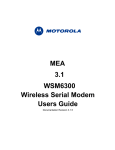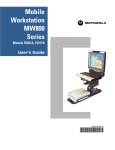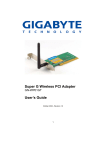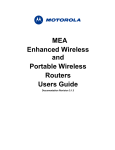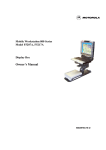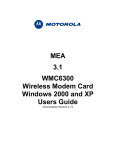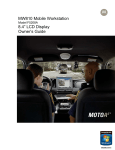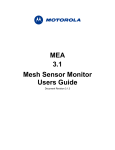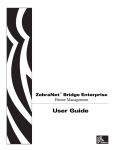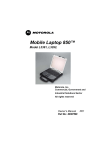Download Motorola WDE1000 Operating instructions
Transcript
6802978C75-C @6802978C75@ July 2006 Disclaimer Statements included in this manual indicating support provided by Motorola are subject to changes at any time. Motorola reserves the right to make changes to this manual. Declaration of Conformity Per FCC CFR 47 Part 2 Section 2.1077(a) Responsible Party Name: Motorola, Inc. Address: 1301 East Algonquin Road Schaumburg, IL 60196 USA Phone Number: 1-800-221-7144 Hereby declares that the product: Product Name:WDE1000/WDE1100 Model Number: F2889A/F2892A Conforms to the following regulations: FCC Part 15, subpart B, section 15.107(a), 15.107(d) and section 15.109(a) Class B Digital Device • This equipment has been NOTE tested and found to comply with the limits for a Class B digital device, pursuant to part 15 of the FCC Rules. These limits are designed to provide reasonable protection against harmful interference in a residential installation. This equipment generates, uses and can radiate radio frequency energy and, if not installed and used in accordance with the instructions, may cause harmful interference to radio communications. However, there is no guarantee that interference will not occur in a particular installation. • Per FCC Rule Part 15.21, changes or modifications not expressly approved by Motorola could void the user's authority to operate the WDE1000/1100. If this equipment does cause harmful interference to radio or television reception, which can be determined by turning the equipment off and on, the user is encouraged to try to correct the interference by one or more of the following measures: • Reorient or relocate the receiving antenna. • Increase the separation between the equipment and receiver. • Connect the equipment into an outlet on a circuit different from that to which the receiver is connected. • Consult the dealer or an experienced radio/TV technician for help. As a personal computer peripheral, this device complies with Part 15 of the FCC Rules. Operation is subject to the following two conditions: (1) this device may not cause harmful interference, and (2) this device must accept any interference received, including interference that may cause undesired operation. FCC ID: AZ489FT7016 refers to WDE1000 FCC ID: AZ489FT7023 refers to WDE1100 ii NOTE WDE1100 only. WDE1100 is an OEM module and is intended only for OEM integrators under the following conditions: 1. The antenna should be installed so there is at least 20cm of separation between the body of the user and nearby persons and the antenna. 2. The OEM Module may not be co-located with any other transmitter or antenna. 3. The antenna installation of this OEM Module, including antenna gain, must satisfy the requirements as specified in FCC ID: AZ489FT7023 grant of equipment authorization. As long as the above conditions are met, further transmitter tests will not be required. However, the OEM integrator is still responsible for testing their end product for any additional compliance requirements required with this Module installed. If the above conditions can not be met then the FCC authorization is no longer considered valid and the FCC ID can not be used on the final product. In this case, the OEM Integrator will be responsible for reevaluation of the end product, including the transmitter, and obtaining a separate FCC authorization. Regulatory Requirements The Federal Communications Commission (FCC) requires application for certification of digital devices in accordance with CFR Title 47, Part 15 and Part 90. This includes Electromagnetic Energy Exposure (EME) testing. As the WDE1000/1100 is not a stand-alone modem but is a PC card/Mini PCI, the WDE1000/1100 cannot be tested by itself for EME certification and was tested while inserted in a laptop computer. This device complies with Part 15 of the FCC Rules. Operation is subject to the following two conditions: (1) This device may not cause harmful interference, and (2) This device must accept any interference received, including interference that may cause undesired operation. The WDE1000/1100 transmitters, [email protected] and 802.11b/[email protected] will not work simultaneously when used in the present configuration. NOTE WDE1000 only. The WDE1000 was approved by the United States Federal Communications Commission (FCC) for use with internal on board antennas. For external antenna use in the United States, the Federal Communications Commission (FCC) requires that an approval will be obtained. Safety and General Information IMPORTANT INFORMATION ON SAFE AND EFFICIENT OPERATION. READ THIS INFORMATION BEFORE USING YOUR MOTOROLA WDE1000/1100. RF Operational Characteristics Your Motorola product contains a radio frequency transmitter to convey the information you wish to send as well as occasional automatic signals used to sustain connection to the wireless network, and a receiver which enables you to receive communication and connection information from the network. Antenna Care (WDE1000 only) Use only the supplied or an approved replacement antenna. Unauthorized antennas, modifications, or attachments could damage the radio product and may violate FCC regulations. When using any approved accessory antenna, position it at least eight inches (20 cm) from any part of any person. DO NOT hold the antenna when the radio product is "IN USE". Holding the antenna affects communication quality and may cause the product to operate at a higher power level than needed. Compliance and Control Guidelines and Operating Instructions for WDE1100 Installed as Fixed Site If WDE1100 is installed at a fixed location and operated as a fixed unit, the antenna installation must comply with the following requirements in order to ensure optimal performance and compliance with the RF energy exposure limits in the standards and guidelines listed in “Product Operation and EME Exposure” on page iv: • The antenna should be mounted outside the building on the roof or a tower if at all possible. iii • As with all fixed site antenna installations, it is the responsibility of the licensee to manage the site in accordance with applicable regulatory requirements and may require additional compliance actions such as site survey measurements, signage, and site access restrictions in order to ensure that exposure limits are not exceeded. Product Operation and EME Exposure Your Motorola product is designed to comply with the following national and international standards and guidelines regarding exposure of human beings to radio frequency electromagnetic energy (EME): • United States Federal Communications Commission, Code of Federal Regulations; 47 CFR part 2 sub-part J. • American National Standards Institute (ANSI) / Institute of Electrical and Electronics Engineers (IEEE). C95. 1-1992. • Institute of Electrical and Electronics Engineers (IEEE). C95. 1-1999 Edition. • International Commission on Non-Ionizing Radiation Protection (ICNIRP) 1998. • Ministry of Health (Canada). Safety Code 6. Limits of Human Exposure to Radiofrequency Electromagnetic Fields in the Frequency Range from 3 kHz to 300 GHz, 1999. • Australian Communications Authority Radiocommunications (Electromagnetic Radiation - Human Exposure) Standard 2003. • ANATEL, Brasil Regulatory Authority, Resolution 303 (July 2, 2002) "Regulation of the limitation of exposure to electrical, magnetic, and electromagnetic fields in the radio frequency range between 9 kHz and 300 GHz." "Attachment to Resolution 303 from July 2, 2002." The WDE1000 has been tested for compliance with FCC RF exposure limits in laptop computer configurations with side PCMCIA slots, and can be used in laptop computers with substantially similar physical dimensions, construction, and electrical and RF characteristics. FCC ID: AZ489FT7016 MEET THE GOVERNMENT'S REQUIREMENTS FOR EXPOSURE TO RADIO WAVES. Your WDE1000 is a radio transmitter and receiver. It is designed and manufactured not to exceed the emission limits for exposure to radiofrequency (RF) energy set by the Federal Communications Commission of the U.S. Government. These limits are part of comprehensive guidelines and establish permitted levels of RF energy for the general population. The guidelines are based on standards that were developed by independent scientific organizations through periodic and thorough evaluation of scientific studies. The iv standards include a substantial safety margin designed to assure the safety of all persons, regardless of age and health. The exposure standard for WDE1000 employs a unit of measurement known as the Specific Absorption Rate, or SAR. The SAR limit set by the FCC is 1.6W/kg.(1) Tests for SAR are conducted using standard operating positions reviewed by the FCC with the WDE1000 transmitting at its highest certified power level in all tested frequency bands. Although the SAR is determined at the highest certified power level, the actual SAR level of the WDE1000 while operating can be well below the maximum value. This is because the WDE1000 is designed to operate at multiple power levels so as to use only the power required to reach the network. Before a WDE1000 model is available for sale to the public, it must be tested and certified to the FCC that it does not exceed the limit established by the government-adopted requirement for safe exposure. The tests are performed in positions and locations as required by the FCC for each model. The FCC has granted an Equipment Authorization for this WDE1000 with all reported SAR levels evaluated as in compliance with the FCC RF exposure guidelines. SAR information on this WDE1000 is on file with the FCC and can be found under the Display Grant section of http://www.fcc.gov/oet/fccid after searching on FCC ID: AZ489FT7016. (1) In the United States and Canada, the SAR limit for modems used by the public is 1.6 watts/kg (W/kg) averaged over one gram of tissue. The standard incorporates a substantial margin of safety to give additional protection for the public and to account for any variations in measurements. FCC ID: AZ489FT7023 MEET THE GOVERNMENT'S REQUIREMENTS FOR EXPOSURE TO RADIO WAVES. Your WDE1100 is a radio transmitter and receiver. It is designed and manufactured not to exceed the emission limits for exposure to radiofrequency (RF) energy set by the Federal Communications Commission of the U.S. Government. These limits are part of comprehensive guidelines and establish permitted levels of RF energy for the general population. The guidelines are based on standards that were developed by independent scientific organizations through periodic and thorough evaluation of scientific studies. The standards include a substantial safety margin designed to assure the safety of all persons, regardless of age and health. After integration, this device uses electromagnetic energy in the RF spectrum to provide communications between two or more users over a distance. It uses radio frequency energy or radio waves to send and receive information. The integrated radio generates measurable RF energy only while it is transmitting (during talking or sending data), not when it is receiving (listening or receiving data) or in standby mode. Before a WDE1100 model is available for sale to the public, it must be tested and certified to the FCC that it does not exceed the limit established by the government-adopted requirement for safe exposure. The tests are performed in positions and locations as required by the FCC for each model. The FCC has granted an Equipment Authorization for this WDE1100 with all reported MPE as in compliance with the FCC RF exposure guidelines. MPE information on this WDE1100 is on file with the FCC and can be found under the Display Grant section of http://www.fcc.gov/oet/fccid after searching on FCC ID: AZ489FT7023. Hearing Aids Some digital wireless modem products may interfere with some hearing aids. In the event of such interference, you may want to consult your hearing aid manufacturer to discuss alternatives. Other Medical Devices If you use any other personal medical device, consult the manufacturer of your device to determine if it is adequately shielded from RF energy. Your physician may be able to assist you in obtaining this information. Operational Warnings For Vehicle With Air Bags: ! WARNING Electro Magnetic Interference/Compatibility NOTE Nearly every electronic device is susceptible to electromagnetic interference (EMI) if inadequately shielded, designed or otherwise configured for electromagnetic compatibility. Potentially Explosive Atmospheres Turn off your WDE1000/1100 prior to entering any area with a potentially explosive atmosphere. unless it is a modem product type type especially qualified for use in such areas as “Intrinsically Safe” (for example, Factory Mutual, or CSA). Sparks in a potentially explosive atmosphere can cause an explosion or fire resulting in bodily injury or even death. Facilities To avoid electromagnetic interference and/or compatibility conflicts, turn off your WDE1000/1100 in any facility where posted notices instruct you to do so. Hospitals or health care facilities may be using equipment that is sensitive to external RF energy. ! WARNING Aircraft When instructed to do so, turn off your WDE1000/1100 when on board an aircraft. Any use of a WDE1000/1100 must be in accordance with applicable regulations per airline crew instructions. The areas with potentially explosive atmospheres referred to above include fueling areas such as below decks on boats, fuel or chemical transfer or storage facilities, and areas where the air contains chemicals or particles such as grain, dust or metal powders, and any other area where you would normally be advised to turn off your vehicle engine. Areas with potentially explosive atmospheres are often but not always posted. Blasting Caps and Blasting Areas To avoid possible interference with blasting operations, turn off your WDE1000/1100 when you are near electrical blasting caps, in a blasting area, or in areas posted: "Turn off two-way radio." Obey all signs and instructions. Medical Devices Pacemakers The Advanced Medical Technology Association (AdvaMed) recommends that a minimum separation of 8 inches (20 cm) be maintained between a WDE1000/1100 and a pacemaker. These recommendations are consistent with those of the U.S. Food and Drug Administration. Persons with pacemakers should: • ALWAYS keep the WDE1000/1100 more than 8 inches (20 cm) from their pacemaker when the WDE1000/1100 is turned ON. • Turn the WDE1000/1100 OFF immediately if you have any reason to suspect that interference is taking place. Do not place a WDE1000/1100 in the area over an air bag or in the air bag deployment area. Air bags inflate with great force. If a WDE1000/1100 is placed in the air bag deployment area and the air bag inflates, the WDE1000/1100 may be propelled with great force and cause serious injury to occupants of the vehicle. Operational Cautions ! Caution Cleaning and Drying Considerations This product is not water proof, and exposing the unit to liquids may result in permanent damage to the unit. If your WDE1000/1100 interior gets wet, then do not try to accelerate drying with the use of an oven or a dryer as this will damage the WDE1000/1100 and void the warranty. Instead, do the following: 1. Immediately power off the WDE1000/1100. v 2. 3. Shake excess liquid from WDE1000/1100. Place the WDE1000/1100 in an area that is at room temperature and has good air flow. 4. Let the WDE1000/1100 dry for 72 hours before powering on again. If the WDE1000/1100 does not work after following the steps listed above, contact your dealer for servicing information. Clean the external surfaces of the WDE1000/1100 with a damp cloth, using a mild solution of dishwashing detergent and water. Some household cleaners may contain chemicals that could seriously damage the WDE1000/1100. Avoid the use of any petroleum-based solvent cleaners. Also, avoid applying liquids directly on the WDE1000/1100. Warranty Information If the affected product is being purchased pursuant to a written Communications System Agreement signed by Motorola, the warranty contained in that written agreement will apply. Otherwise, the following warranty applies. What This Warranty Covers And For How Long Motorola Inc. or, if applicable, Motorola Canada Limited ("Motorola") warrants the Motorola manufactured Broadband Data communications product, against material defects in material and workmanship under normal use and service for a period of One (1) Year from the date of shipment. Motorola, at its option, will at no charge either repair the Product (with new or reconditioned parts), replace it with the same or equivalent Product (using new or reconditioned Product), or refund the purchase price of the Product during the warranty period provided purchaser notifies Motorola according to the terms of this warranty. Repaired or replaced Product is warranted for the balance of the original applicable warranty period. All replaced parts of the Product shall become the property of Motorola. This express limited warranty is extended by Motorola to the original end user purchaser purchasing the Product for purposes of leasing or for commercial, industrial, or governmental use only, and is not assignable or transferable to any other party. This is the complete warranty for the Product manufactured by Motorola. Motorola assumes no obligations or liability for additions or modifications to this warranty unless made in writing and signed by an officer of Motorola. Unless made in a separate written agreement between Motorola and the original end user purchaser, Motorola does not warrant the installation, maintenance or service of the Product. to or used in connection with the Product, or for operation of the Product with any ancillary equipment, and all such equipment is expressly excluded from this warranty. Because each system which may use the Product is unique, Motorola disclaims liability for range, coverage, or operation of the system as a whole under this warranty. General Provisions This warranty sets forth the full extent of Motorola's responsibilities regarding the Product. Repair, replacement or refund of the purchase price, at Motorola's option, is the exclusive remedy. THIS WARRANTY IS GIVEN IN LIEU OF ALL OTHER EXPRESS WARRANTIES. MOTOROLA DISCLAIMS ALL OTHER WARRANTIES OR CONDITIONS, EXPRESS OR IMPLIED, INCLUDING THE IMPLIED WARRANTIES OR CONDITIONS OF MERCHANTABILITY AND FITNESS FOR A PARTICULAR PURPOSE. IN NO EVENT SHALL MOTOROLA BE LIABLE FOR DAMAGES IN EXCESS OF THE PURCHASE PRICE OF THE PRODUCT, FOR ANY LOSS OF USE, LOSS OF TIME, INCONVENIENCE, COMMERCIAL LOSS, LOST PROFITS OR SAVINGS OR OTHER INCIDENTAL, SPECIAL, INDIRECT OR CONSEQUENTIAL DAMAGES ARISING OUT OF THE USE OR INABILITY TO USE SUCH PRODUCT, TO THE FULL EXTENT SUCH MAY BE DISCLAIMED BY LAW. How To Get Warranty Service? Purchaser must notify Motorola's representative or call Motorola's Customer Response Center at 1-800-247-2346 within the applicable warranty period for information regarding warranty service. What Is Not Covered By The Warranty 1. Defects or damage resulting from use of the Product in 2. 3. 4. 5. 6. 7. Motorola cannot be responsible in any way for any ancillary equipment not furnished by Motorola which is attached vi 8. other than its normal and customary manner. Defects or damage from misuse, accident, water, or neglect. Defects or damage from improper testing, operation, maintenance, installation, alteration, modification, or adjustment. Breakage or damage to antennas unless caused directly by defects in material workmanship. A Product subjected to unauthorized Product modifications, disassemblies or repairs (including, without limitation, the addition to the Product of non-Motorola supplied equipment) which adversely affect performance of the Product or interfere with Motorola's normal warranty inspection and testing of the Product to verify any warranty claim. Product which has had the serial number removed or made illegible. Batteries (they carry their own separate limited warranty). Freight costs to the repair depot. 9. A Product which, due to illegal or unauthorized alteration of the software/firmware in the Product, does not function in accordance with Motorola's published specifications or with the FCC type acceptance labeling in effect for the Product at the time the Product was initially distributed from Motorola. 10. Scratches or other cosmetic damage to Product surfaces that does not affect the operation of the Product. 11. That the software in the Product will meet the purchaser's requirements or that the operation of the software will be uninterrupted or error-free. 12. Normal and customary wear and tear. 13. Non-Motorola manufactured equipment unless bearing a Motorola Part Number in the form of an alpha numeric number (i.e., TDE6030B). 14. Lift trucks for installation, removal, replacement or repair of the Motorola supplied products from light, power, telephone poles etc. 15. Dispatch to remote site locations. 16. Loading of software upgrades or fixes into the devices. Governing Law In the case of a Product sold in the United States and Canada, this Warranty is governed by the laws of the State of Illinois and the Province of Ontario, respectively. Patent and Software Provisions Motorola will defend, at its own expense, any suit brought against the end user purchaser to the extent that it is based on a claim that the Product or its parts infringe a United States patent, and Motorola will pay those costs and damages finally awarded against the end user purchaser in any such suit which are attributable to any such claim, but such defense and payments are conditioned on the following: 1. that Motorola will be notified promptly in writing by such purchaser of any notice of such claim; 2. that Motorola will have sole control of the defense of such suit and all negotiations for its settlement or compromise; and should the Product or its parts become, or in Motorola's opinion be likely to become, the subject of a claim of infringement of a United States patent, that such purchaser will permit Motorola, at its option and expense, either to procure for such purchaser the right to continue using the Product or its parts or to replace or modify the same so that it becomes noninfringing or to grant such purchaser a credit for the Product or its parts as depreciated and accept its return. The depreciation will be an equal amount per year over the lifetime of the Product or its parts as established by Motorola. Motorola will have no liability with respect to any claim of patent infringement which is based upon the combination of the Product or its parts furnished hereunder with software, apparatus or devices not furnished by Motorola, nor will Motorola have any liability for the use of ancillary equipment or software not furnished by Motorola which is attached to or used in connection with the Product. The foregoing states the entire liability of Motorola with respect to infringement of patents by the Product or any its parts thereof. Laws in the United States and other countries preserve for Motorola certain exclusive rights for copyrighted Motorola software such as the exclusive rights to reproduce in copies and distribute copies of such Motorola software. Motorola software may be used in only the Product in which the software was originally embodied and such software in such Product may not be replaced, copied, distributed, modified in any way, or used to produce any derivative thereof. No other use including, without limitation, alteration, modification, reproduction, distribution, or reverse engineering of such Motorola software or exercise of rights in such Motorola software is permitted. No license is granted by implication, estoppel or otherwise under Motorola patent rights or copyrights. vii This Page Left Blank Intentionally viii WDE1000/1100 User’s Guide Contents Disclaimer ................................................................................................................................ ii Declaration of Conformity....................................................................................................... ii Regulatory Requirements ....................................................................................................... iii Safety and General Information.............................................................................................. iii Warranty Information ............................................................................................................. vi PREFACE ................................................................................................................. 1 Scope of This Manual ............................................................................................................... 1 Arrangement of This Manual.................................................................................................... 1 Applicable Documentation ....................................................................................................... 1 CHAPTER 1 - INTRODUCTION .......................................................................... 3 General Description .................................................................................................................. 3 WDE1000/1100 Specifications................................................................................................. 5 CHAPTER 2 - INSTALLATION ........................................................................... 9 Your Package Content .............................................................................................................. 9 Getting to Know Your WDE1000 .......................................................................................... 10 Inserting WDE1000 Into Your Laptop Computer .................................................................. 11 Removing WDE1000 from Your Laptop Computer .............................................................. 11 System Requirements ............................................................................................................. 12 Installing the MCU (Motorola Client Utility) Application..................................................... 13 Uninstalling the MCU (Motorola Client Utility) Application ................................................ 27 Upgrading the MCU (Motorola Client Utility) Application................................................... 29 CHAPTER 3 - OPERATION................................................................................ 31 Using the MCU ....................................................................................................................... 31 Configuring a new profile....................................................................................................... 32 Activating and Using Your New Profile................................................................................. 45 LED Indicators Operation....................................................................................................... 48 CHAPTER 4 - TROUBLESHOOTING ............................................................... 49 General.................................................................................................................................... 49 ix CHAPTER 5 - GLOSSARY ................................................................................. 51 APPENDIX A - DISABLING/REMOVING WIFI DRIVERS.......................... 55 General.................................................................................................................................... 55 Disabling WiFi Drivers........................................................................................................... 55 For Windows XP Operating System................................................................................. 55 For Windows 2000 Operating System.............................................................................. 56 APPENDIX B - OVER THE AIR PROGRAMMING ....................................... 59 General.................................................................................................................................... 59 Upgrading the MCU SW Version (Silent Installation)........................................................... 59 General.............................................................................................................................. 59 Detailed Procedure............................................................................................................ 59 Updating and Setting Profiles ................................................................................................. 62 General.............................................................................................................................. 62 Detailed Procedure............................................................................................................ 62 x WDE1000/1100 User’s Guide - Preface Preface Scope of This Manual This manual provides instructions for the operation of the WDE1000 (Wireless Device Enabler) WLAN CardBus Adaptor and the WDE1100 Mini PCI card. Arrangement of This Manual This manual is arranged as follows: • Preface - Contains the scope of the manual and its arrangement. • Chapter 1-Introduction - Gives a general description of the WDE1000/1100 and its specifications. • Chapter 2-Installation - Gives information about your WDE1000/1100 package content and instructions that will enable you to install the card and its operating software. • Chapter 3 - Operation - Provides you with the information required for setting-up your software and some initial operation instructions. • Chapter 4 - Troubleshooting - Gives a list of possible malfunctions that could occur during software installation and operation and possible ways to correct them. • Chapter 5 - Glossary - Gives an explanation to terms and abbreviations that appear in the manual. Applicable Documentation • • • For additional information regarding Motorola Client Utility (MCU) application configuration and use, refer to the On-line Help that is supplied with the application. Motorola Client Utility (MCU) for WDE1000/1100 Quick Reference Card - P/N 6802981C05. WDE1100 Mini PCI Card Installation Guide - P/N 6802980C85. 1 Preface This page left blank intentionally 2 WDE1000/1100 User’s Guide - Chapter 1 - Introduction Chapter 1 - Introduction General Description The Wireless Device Enabler (WDE) CardBus adaptor, referred to throughout this manual as WDE1000 and the Mini PCI that is referred to as WDE1100, provides modem functionality so that a client is able to access the WLAN communication services provided by the system network. This network is an adaptation of an 802.11 System, which provides wireless access to an IP network using the 4.9 GHz licensed / 2.4 GHz unlicensed spectrum. The system enables the WLAN user to transmit and receive data at rates of up to 54 Megabits per second (Mbps) by using a version of the 802.11a standard which is adapted for use in the 4.9 GHz band, or 802.11b/g standard for the 2.4 GHz band. The WDE is supplied in one of two forms: • A CardBus adaptor, which is also known by its more generic label as a PCMCIA card (WDE1000). • A Mini PCI card. Mini PCI cards are commonly used to add WLAN functionality to notebook computers such that the function is fully enclosed by the housing of the notebook (WDE1100). NOTE In this manual we refer to the CardBus form (WDE1000) that has the same functionality as the Mini PCI card (WDE1100). The WDE1000/1100 has the following high level features: • 2.4 GHz/4.9 GHz band coverage. • 100 mW typical transmit power at 4.9 GHz and 63 mW at 2.4 GHz. • FCC 4.9 GHz high power mask. • Power save mode (for infrastructure communication mode only). • 802.11e QoS support (EDCA only). • Two internal antennas and two connectors for external antennas. • Switched Rx antenna diversity. • PCMCIA (32 bit) card. The WDE1000/1100 supports two operational communication modes: • Infrastructure - The WDE1000/1100 communicates with the network via system infrastructure. • Ad-hoc - The WDE1000/1100 communicates with another nearby WDE1000, without using system infrastructure. A Motorola Client Utility (MCU) application, used with the WDE1000/1100 allows configuration and monitoring of the connection. A system tray allows WDE1000/1100 status monitoring. 3 Chapter 1 - Introduction A general view of the WDE1000 is shown in Figure 1. A general view of the WDE1100 is shown in Figure 2. Figure 1. WDE1000 - General View Figure 2. WDE1100 - General View NOTE 4 The WDE1100 is installed inside your Laptop computer and is not visible during normal operation. WDE1000/1100 User’s Guide - Chapter 1 - Introduction WDE1000/1100 Specifications Frequency Range: 802.11b/g: 2.4~2.4835GHz modified 802.11a @ 4.9GHz: 4.94~4.99GHz Modulation Technique: 802.11b (DSSS and CCK) 802.11g (DSSS, CCK and OFDM) modified 802.11a @ 4.9GHz (OFDM) Output Power (typical): 802.11b/g: 18dBm for all modulation rates 4.9GHz band: 20MHz channel: 20dBm for all modulation rates 10MHz channel: 20dBm for all modulation rates 5MHz channel: 20dBm for all modulation rates Regulatory Compliance: FCC CFR47 Part 90 Certified at 4.9 GHz and Part 15,247 Certified at 2.4 GHz Average Antenna Gain (typical): WDE1000: 802.11b/g: 0dBi (on board integral antenna) 4.9GHz band: 0dBi (on board integral antenna) Supports external antenna via MMCX connector WDE1100: 2 UFL external diversity antenna ports (one for each frequency in TX mode. 5 Chapter 1 - Introduction Operation Modes: BSS (Infrastructure) IBSS (ad-hoc) Operating Temperature: -30 to +60 degrees Celsius Storage Temperature: -40 to +85 degrees Celsius Operating Voltage: 3.3V + 10% Dimensions (W x L x H): WDE1000 54 x 129 x 5mm (height is 13.8mm at extension board) WDE1100 44.6 x 59.8 x 4.9mm Weight: WDE1000 72g WDE1100 14.2g Host Interface: WDE1000 - CardBus 32 bits WDE1100 - Mini PCI Channel Support: 802 b/g US: 11 (1~11) 6 WDE1000/1100 User’s Guide - Chapter 1 - Introduction Modified 802.11a 1 2 3 7 overlapping 20 MHz bandwidth channels 9 overlapping 10 MHz bandwidth channels 10 overlapping 5 MHz bandwidth channels Operating System: Windows 2000 (Service Pack 4) Windows XP Professional (Service Pack 2) Windows XP Tablet (Service Pack 2) 7 Chapter 1 - Introduction This page left blank intentionally 8 WDE1000/1100 User’s Guide - Chapter 2 - Installation Chapter 2 - Installation Your Package Content Verify that your WDE1000 package contains the following: Item # Item Description 1 WDE1000 HKLN4273A 1.1 WDE1000 Card F2889A 1 1.2 CD-ROM HKVN4003A 1 Model Number Quantity Verify that your WDE1100 package contains the following: Item # Item Description 1 WDE1100 HK1276A 1.1 WDE1100 Mini PCI Card F2892A 1 1.2 CD-ROM HKVN4003A 1 NOTE Model Number Quantity For WDE1100 installation instructions, refer to WDE1100 Mini PCI Card Installation Guide - P/N 6802980C85. 9 Chapter 2 - Installation Getting to Know Your WDE1000 Figure 3 gives a detailed description of the WDE1000: LED Indicators External Antenna Connectors Cover WDE1000 - Upper View Internal Antenna WDE1000 - Bottom View Figure 3. WDE1000 - Detailed Description 10 WDE1000/1100 User’s Guide - Chapter 2 - Installation Inserting WDE1000 Into Your Laptop Computer Perform the following steps (see Figure 4): 1. Gently insert the WDE1000 into the PCMCIA slot. Verify that the card is sliding along the guides. Laptop Computer Push Card Inside PCMCIA Slot PCMCIA Slot Figure 4. WDE1000 - Installing on a Laptop 2. Push the card into the Laptop PCMCIA connector. Removing WDE1000 from Your Laptop Computer Perform the following steps: 1. Press and release the PCMCIA release button to extend it out (see Figure 5). 2. Press the PCMCIA release button again to release the WDE card. 11 Chapter 2 - Installation 3. Gently pull the card out from the slot. Pull Card Out from PCMCIA Slot PCMCIA Release Button Figure 5. WDE1000 - Removing from a Laptop System Requirements The Motorola Client Utility (MCU) requires an IBM PC or compatible computer with the following minimum configuration: Processor: Pentium® IV 1.5 GHz or higher Memory (RAM): 256 MB PCMCIA slot (for WDE1000): At least one available Free hard disk space: 20 MB Drive: CD-ROM Operating System: Microsoft Windows® 2000 (Service Pack 4) or Microsoft Windows® XP Professional (Service Pack 2) or Microsoft Windows® Tablet (Service Pack 2) 12 WDE1000/1100 User’s Guide - Chapter 2 - Installation Installing the MCU (Motorola Client Utility) Application The MCU must be installed by a system administrator. NOTE The WDE1000 must be inserted, or WDE1100 installed into your laptop computer before installing the MCU (Motorola Client Utility) application (see “Inserting WDE1000 Into Your Laptop Computer” on page 11 or WDE1100 Mini PCI Card Installation Guide - P/N 6802980C85). When inserting the WDE1000 into your laptop computer before the installation, a “New Hardware Found” pop-up dialog appears. Press “CANCEL” weather the driver name is displayed or not. Perform the following steps: 1. Quit all Windows applications. 13 Chapter 2 - Installation 2. Insert your WDE1000 into your laptop, or verify that the WDE1100 is installed in your laptop. The following screen appears after few seconds for first installation: 3. Press Cancel button. 4. Insert the MCU CD-ROM into your CD-ROM Drive. 14 WDE1000/1100 User’s Guide - Chapter 2 - Installation 5. In case the setup application does not start automatically, press Start button at the bottom Windows bar, select Run, type e:\setup.exe (the letter “e” stands for your CD-ROM drive letter) and press Ok. The following screen appears: 15 Chapter 2 - Installation 6. In case other WiFi application installed on your Laptop is using the same services that WDE1000/ 1100 card uses, the following screen appears: NOTE It is strongly recommended to uninstall or at least disable all WiFi applications installed on your Laptop before the installation. You may try and proceed with the installion process without taking any action. In case that the MCU application is blocked, you'll be required to disable or uninstall these applications and reinstall the MCU application. For more details, refer to “Appendix A - Disabling/Removing Wifi Drivers” on page 55. 7. Close all applications and press OK on the following screen. 16 WDE1000/1100 User’s Guide - Chapter 2 - Installation 8. The following screen appears after few seconds: 17 Chapter 2 - Installation 9. Press Next. The following screen appears: 10. Read the License Agreement. To continue with the installation, mark the “I accept the terms of the license agreement” and press Next. NOTE 18 If your WDE1000 is inserted into the laptop, steps 11 through 13 should be omitted. WDE1000/1100 User’s Guide - Chapter 2 - Installation 11. If the WDE1000 is not inserted into your laptop, the following screen appears: 12. Insert the WDE1000 and press Next. 19 Chapter 2 - Installation 13. Press Cancel if the following screen appears: 20 WDE1000/1100 User’s Guide - Chapter 2 - Installation 14. If you have accepted the license agreement and the WDE1000 is inserted, the following screen appears: 21 Chapter 2 - Installation 15. Accept the default installation location or browse to select another location and press Next. The following screen appears: This page left blank intentionally 16. Accept the program folder name or change it and press Next. NOTE 22 If your computer is equipped with Microsoft Windows 2000, steps 17 through 19 should be omitted. WDE1000/1100 User’s Guide - Chapter 2 - Installation 17. When installing the MCU on a computer using Windows XP operating system, the following screen appears: 23 Chapter 2 - Installation 18. Read the recommendation and press Next. The following screen appears: 19. Select the MCU as your configuration tool and press Next. 24 WDE1000/1100 User’s Guide - Chapter 2 - Installation 20. The application is being installed. The following Setup Status screen appears: 25 Chapter 2 - Installation 21. When the Setup Status bar is full, the following screen appears indicating the successful completion of the installation: This page left blank intentionally 22. Select the “Yes, I want to restart my computer now” and press Finish to end the installation process.. You must restart your computer before attempting to use the MCU. NOTE 23. The setup application creates an MCU shortcut icon on your laptop desktop: 26 WDE1000/1100 User’s Guide - Chapter 2 - Installation Uninstalling the MCU (Motorola Client Utility) Application NOTE NOTE The WDE1000 must be inserted into your laptop computer before uninstalling the MCU (Motorola Client Utility) application (see “Inserting WDE1000 Into Your Laptop Computer” on page 11). The uninstall process deletes all existing profiles. If you wish to save your profiles, use the "Export" button to save each one of them separately before starting to uninstall and after the installation use the "Import" button to restore them. Perform the following steps: 1. Close the MCU application. NOTE Use the CD-ROM that contains your installed version of MCU, or a new version of MCU if you are upgrading the application. 2. Insert the MCU CD-ROM into your CD-ROM Drive. 3. In case the setup application does not start automatically, press Start button at the bottom Windows bar, select Run, type e:\setup.exe (the letter “e” stands for your CD-ROM drive letter) and press Ok. The following screen appears: 27 Chapter 2 - Installation 4. Close all applications and press Ok. The following screen appears: This page left blank intentionally 5. Check the “Uninstall the previous installation” and click Next. The following screen appears: 6. Click the Ok button. The MCU is being uninstalled. 7. Restart your computer when requested. You must restart your computer to complete full removal of the MCU. NOTE 28 WDE1000/1100 User’s Guide - Chapter 2 - Installation Upgrading the MCU (Motorola Client Utility) Application NOTE The WDE1000 must be inserted into your laptop computer before updating the MCU (Motorola Client Utility) application (see “Inserting WDE1000 Into Your Laptop Computer” on page 11). 1. Perform steps 1 through 4 of “Uninstalling the MCU (Motorola Client Utility) Application” on page 27. 2. In the screen that appear after step 4, check the “Update the previous installation” and click Next. The MCU is being updated. 3. Restart your computer when requested. You must restart your computer to complete full update of the MCU. NOTE NOTE For upgrading the MCU using “Over the Air Programming” refer to “Appendix B - Over the Air Programming” on page 59. 29 Chapter 2 - Installation This page left blank intentionally 30 WDE1000/1100 User’s Guide - Chapter 3 - Operation Chapter 3 - Operation Using the MCU NOTE Verify that the WDE1000 is installed in the same PCMCIA slot it was inserted to when you have installed the MCU. Required slot number is indicated on the application name bar of the MCU (e.g. [Slot #1]). 1. Double click on the MCU shortcut to open the application. The following screen appears while the WDE1000/1100 is attempting to connect to the network: 31 Chapter 3 - Operation NOTE Your MCU attempts to connect to the network using a default connection profile. You may edit this profile or create a new one to suit your needs. Configuring a new profile Perform the following steps: 1. Click the Profile Management tab. The following screen appears: NOTE 32 If you are creating a new profile without scanning for an available network, start from step 7. WDE1000/1100 User’s Guide - Chapter 3 - Operation 2. If you want to find an available network (according to the active profile) and create a new profile based on it, click Scan on the Profile Management window. The Available Infrastructure and Ad Hoc Networks window appears: 3. Select the desired Network Name (Infrastructure or Ad-hoc) and click Activate. The following window appears: 33 Chapter 3 - Operation 4. Insert the Profile Name, see following window: 5. Click OK. The following window appears: 34 WDE1000/1100 User’s Guide - Chapter 3 - Operation 6. Your new profile is now active. NOTE Step 7 and on apply if you are creating a new profile without using the Scan. 7. Press the New button. The following screen appears: 35 Chapter 3 - Operation 8. Enter the profile name and the Network Name (SSID1) in the dedicated fields: Network Name is mandatory for Adhoc profile types only. NOTE 36 WDE1000/1100 User’s Guide - Chapter 3 - Operation 9. Click the Advanced tab. The following screen appears: 37 Chapter 3 - Operation 10. Using the Network Type drop-down menu, select Infrastructure or Ad hoc (see following screen): 38 WDE1000/1100 User’s Guide - Chapter 3 - Operation 11. Using the Power Save Mode drop-down menu, select the desired mode (see following screen): Power Save Mode menu is disabled for Ad-hoc profile types. NOTE 39 Chapter 3 - Operation 12. Using the Transmit Power Level drop-down menus, select the desired power level for 802.11b/g and 802.11a (see following screen): 40 WDE1000/1100 User’s Guide - Chapter 3 - Operation 13. Select the frequency band of the wireless mode by checking the desired check box. 14. If you’ve checked the 4.9 GHz band, use the drop-down menu to select the bandwidth (see following screen): 41 Chapter 3 - Operation 15. When configuring an Ad hoc profile, select the desired Wireless Mode When Starting Ad Hoc Network band (see following screen): NOTE 42 Your WDE uses the above selection to determine the wireless mode it will use if, while in Ad-hoc, no other WDE was found and no association is possible. WDE1000/1100 User’s Guide - Chapter 3 - Operation 16. Click the Security tab and select your desired security level (see following screen): 43 Chapter 3 - Operation 17. Press the Ok button. The following screen appears: 44 WDE1000/1100 User’s Guide - Chapter 3 - Operation Activating and Using Your New Profile 1. To use your new profile, select the profile name (see previous screen) and press the Activate button. The following screen appears: 45 Chapter 3 - Operation 2. Click the Current Status tab to monitor the WDE1000 status. While the card is scanning for a communication channel, the following screen appears: 3. When scanning is finished and a channel is found, communication is established. The following screen appears: 46 WDE1000/1100 User’s Guide - Chapter 3 - Operation 4. Using the Action drop-down menu, activate the antenna type you are using (internal or external). See following screen: NOTE If you’ve activated the external antenna, the next time you will use this drop-down menu, the internal antenna activation will be available and vice versa. Antenna activation is not available for WDE1100. 5. You are now ready for data transfer operation.: NOTE To upgrade and select profiles using “Over the Air Programming”, refer to “Appendix B - Over the Air Programming” on page 59. 47 Chapter 3 - Operation LED Indicators Operation Your WDE1000 is equipped with two LED indicators. LEDs indications are described in Table 4. TABLE 4. Indication LEDs Power LED (Green) Network LED (Green) Indication Off Off WDE1000 is not receiving power. Blinking slowly Off WDE1000 is in power save mode. On Off WDE1000 has awakened from power save mode. Alternating blink: 48 WDE1000 is scanning for the wireless network for which it is configured. On Off Off On Blinking slowly Blinking slowly WDE1000 is associated to an access point (in infrastructure mode) or another WDE card (in ad hoc mode). Blinking Rapidly Blinking Rapidly WDE1000 is transmitting or receiving data while associated to an access point (in infrastructure mode) or another WDE card (in ad hoc mode). WDE1000/1100 User’s Guide - Chapter 4 - Troubleshooting Chapter 4 - Troubleshooting General The following table will help you in troubleshooting possible malfunctions that may appear during WDE1000/1100 operation. No. Malfunction Possible Correction 1. The MCU does not detect the WDE1000/1100 or, the internal WiFi card stopped working. Probably caused by conflict problems between the WDE1000/1100 and other WiFi cards using the same Atheros chipset (Cisco, D-Link, Proxim, etc.) during installation process. Uninstall the MCU package, deactivate or uninstall other WiFi cards (see “Appendix A - Disabling/Removing Wifi Drivers” on page 55) and reinstall the MCU. 2. The computer does not recognize the WDE1000/1100. 1. Verify that the WDE1000 is fully inserted into the PCMCIA slot. 2. Verify that the WDE1000 is inserted into the same PCMCIA slot it was inserted to when installing the MCU. 3. Verify that the WDE1100 is correctly installed in your laptop (refer to WDE1100 Mini PCI Card Installation Guide, P/N 6802980C85). 3. WDE1000/1100 fails to associate. 1. Verify that the card is inserted into your laptop, check that it is working properly using your Windows Device Manager. 2. Verify that the access point receives power and is operating. 3. Verify that your WDE1000/1100 is configured to the correct band of the access point (2.4GHz or 4.9GHz). 4. Verify that your WDE1000/1100 profile SSID matched the access point SSID. 5. If encryption is enabled in the access point, verify that your WDE1000/1100 is configured with the same security key. 4. The WDE1000/1100 cannot communicate with other computers linked via wireless in Infrastructure network type. 1. Verify that each Wireless PC Card is configured on the same SSID, Network Type (Infrastructure or Ad Hoc), common wireless mode (2.4GHz 11Mbs, 2.4GHz 54 Mbps, 4.9 GHz), common bandwidth for 4.9 GHz, and the same encryption. 2. Verify that TCP/IP is installed. Verify that you are a part of the same domain or workgroup. Verify that you are automatically obtaining the IP address or that you have a correct IP address and subnet mask. 3. Reset the Wireless Access Point and restart the computer that has a connectivity issue. 49 Chapter 4 - Troubleshooting 50 No. Malfunction Possible Correction 5. The WDE1000/1100 cannot communicate with other computers linked via wireless in Ad hoc network type. Verify that one WDE1000/1100 had a complete network initialization, then, activate second party that shall be configured with same SSID name, same wireless mode (2.4GHz 11Mbs,2.4GHz 54 Mbps, 4.9 GHz), same bandwidth for 4.9 GHz, and same encryption. 6. Low performance. Try to create some more distance between the stations (Ad hoc) or between the station and the access point (Infrastructure). Very small distance may create receiver overload. 7. The set of profiles is different when the WDE1000 is inserted into another PCMCIA slot of the same computer. Insert the WDE1000 into the same PCMCIA slot in which it was installed. Profiles are linked to a given slot. 8. The laptop battery is consumed very fast when the WDE1000/1100 is operating. 1. In the active profile, select the specific definitions of the environment in which you want to work, e.g. Wireless Mode and Bandwidth for 4.9 GHz. This will significantly shorten the periodical background scanning process. 2. Select the maximum Power Save mode value in the profile definition. 9. Low performance or unexpected behavior of the WDE1000/1100. Might be caused by conflict problems between WDE1000/1100 and other WiFi cards running at the same time. In this case the applications controlling these cards must be disabled while WDE1000/1100 is running. See “Appendix A - Disabling/Removing Wifi Drivers” on page 55 for disabling other WiFi cards. 10. Your computer restarts work without a reason. Check if your MCU is being upgraded using “Over the Air Programming” refer to “Appendix B - Over the Air Programming” on page 59. WDE1000/1100 User’s Guide - Chapter 5 - Glossary Chapter 5 - Glossary 802.11 The IEEE standard that specifies carrier sense media access control and physical layer specifications for 1 - and 2 - megabit-per-second (Mbps) 2.4GHz wireless LANs. 802.11a The IEEE standard that governs the deployment of 5GHz (4.9) systems. It specifies the implementation of the physical layer for wireless UNII bands and provides four channels per 100MHz of bandwidth. 802.11b The IEEE standard that specifies carrier sense media access control and physical layer specifications for 5.5 - and 11 - Mbps 2.4GHz wireless LANs 802.11g The IEEE standard that specifies carrier sense media access control and physical layer specifications for 54 Mbps 2.4GHz wireless LANs A access point A wireless LAN data transceiver that uses radio waves to connect a wired network with wireless stations. ad hoc network A wireless network composed of stations without access points. associated A station is configured properly to enable it to communicate with an access point. B bandwidth Specifies the amount of the frequency spectrum that is usable for data transfer. It identifies the maximum data rate that a signal can attain on the medium without encountering significant power loss. C client A radio device that uses the service of an access point to communicate wirelessly with other devices on a local area network. D data rates The range of data transmission rates supported by a device. Data rates are measured in megabits per second (Mbps). dBi A ratio of decibels to an isotropic antenna that is commonly used to measure antenna gain. The greater the dBi value, the higher the gain and the more accurate the angle of coverage. 51 Chapter 5 - Glossary E EAP Extensible Authentication Protocol. EAP is the protocol for the optional IEEE 802.1X wireless LAN security feature. An access point that supports 802.1X and EAP acts as the interface between a wireless client and an authentication server, such as a Remote Authentication Dial-In User Service server, to which the access point communicates over the wired network. Ethernet The most widely used wired local area network. Ethernet uses carrier sense multiple access (CSMA) to enable computers to share a network and operates at 10, 100, or 1000 Mbps, depending on the physical layer. G gateway A device that connects two otherwise incompatible networks together. GHz Gigahertz. One billion cycles per second. A unit of measure for frequency. I IEEE Institute of Electrical and Electronics Engineers. A professional society serving electrical engineers through its publications, conferences, and standards development activities. The body responsible for the Ethernet 802.3 and wireless LAN 802.11 specifications. infrastructure The wired Ethernet network. infrastructure device A device (such as access point, bridge, or base station) that connects client adapters to a wired LAN. IP address The Internet Protocol address of a station. L LEAP Lightweight Extensible Authentication Protocol. LEAP is an 802.1X authentication type. With LEAP, a user name and password are used by the client adapter to perform mutual authentication with the server through an access point. M MCU Motorola Client Utility. An application that enables the user to operate the adapter. O OTAP Over the Air Programming P 52 packet A basic message unit for communication across a network. A packet usually includes routing information, data, and sometimes error detection information. PCMCIA Personal Computer Memory Card International Association. WDE1000/1100 User’s Guide - Chapter 5 - Glossary S SSID Service Set Identifier. A unique identifier that stations must use to be able to communicate with an access point. The SSID can be any alphanumeric entry up to a maximum of 32 characters. W WDE Wireless Device Enabler. WiFi Wireless Fidelity alliance Interoperability standard. WLAN Wireless Local Area Network. 53 Chapter 5 - Glossary This page left blank intentionally 54 WDE1000/1100 User’s Guide - Appendix A - Disabling/Removing Wifi Drivers Appendix A - Disabling/Removing Wifi Drivers General Several problems such as WDE1000/1100 MCU application not detecting the WDE1000/1100 card or other internal WiFi cards stopping to work might be caused by conflict problems between WDE1000/1100 card and other WiFi cards using the same Atheros chipset (Cisco, D-Link, Proxim, etc.) during installation process. Other problems such as degradation of WDE1000/1100 performance or unexpected behavior of WDE1000/1100 can also be caused by conflict problems between the WDE1000/1100 and other WiFi cards at running time. In this case, the applications controlling the other cards should be disabled or uninstalled while WDE1000/1100 is running. It is strongly recommended that before MCU installation, other WiFi drivers and applications running on your machine are disabled. If disabling these drivers does not resolve the conflicts, it will be required to uninstall them. To uninstall these drivers, refer to the instructions supplied by the vendor. Refer to the following paragraph for disabling other WiFi Drivers. Disabling WiFi Drivers For Windows XP Operating System 1. Press Start button at the bottom Windows bar and select Run. 2. In the window appears, type: “msconfig”. 3. Press the OK button. 4. The “System Configuration Utility” dialog window appears. 55 Appendix A - Disabling/Removing Wifi Drivers 5. Select the “Startup” tab. 6. Uncheck all running network applications and press OK. 7. Restart your computer. 8. Install the MCU (refer to “Installing the MCU (Motorola Client Utility) Application” on page 13). NOTE To enable the above drivers, repeat the above steps and in the “Startup” tab, check all disabled applications. For Windows 2000 Operating System 1. Move the mouse cursor onto the WiFi application icon, located on the system tray (see example below) and click the mouse right button. 56 WDE1000/1100 User’s Guide - Appendix A - Disabling/Removing Wifi Drivers 2. Select the Wireless Off option (see example below). 3. Verify that the application is disabled. 4. Repeat steps 1-3 for all other existing WiFi applications. NOTE To enable the above drivers, repeat step 1 and select “Wireless On” in step2. 57 Appendix A - Disabling/Removing Wifi Drivers This page left blank intentionally 58 WDE1000/1100 User’s Guide - Appendix B - Over the Air Programming Appendix B - Over the Air Programming General NOTE This feature is intended to be used by administrators that are familiar with the MS SMS tool. Over the Air Programming (OTAP) is a feature that enables upgrading the MCU application through the air. The OTAP also enables sending of profiles and setting the active profile for the user. The following paragraphs give the instructions required to operate the OTAP. NOTE WDE1000 must be inserted into your computer or WDE1100 installed in your computer to enable OTAP operation. Upgrading the MCU SW Version (Silent Installation) General The full upgrade process requires: 1. To send the installation package to the target computer using MS SMS tool. 2. To run the silent installation. Detailed Procedure Silent update will not perform any card driver update. NOTE 1. Place the unzipped upgrade installation package (Disk 1 folder) on the computer. 59 Appendix B - Over the Air Programming 2. Go to DOS, move to the package location and run: Setup.exe /z”OTAP” (see following screen). 60 WDE1000/1100 User’s Guide - Appendix B - Over the Air Programming 3. The update package is installed now. The following screen appears: NOTE The installation is performed without the need of user intervention. Screens will be displayed as the installation is progressing. 4. After the installation process ends, the computer preforms an un-notified restart (see following message). This apply to computers with Windows XP operating system only. 5. Your computer is ready now to activate the updated MCU version. 61 Appendix B - Over the Air Programming Updating and Setting Profiles General Updating and setting profiles require: Source computer 1. To perform Export all profiles. 2. To send the profiles and MTU.exe to the target computer. Target computer 1. To run the profile setting update process. Detailed Procedure Preparing the Profiles Package NOTE The following activities are done on the station that is sending the profiles update. 1. Activate the MCU. 2. Configure the required profiles (refer to “Configuring a new profile” on page 32). NOTE Before attempting to perform the next step, verify that the Profile Management tab of your MCU is pressed. 3. Using the Action drop-down menu, select Export All. The following message appears: 62 WDE1000/1100 User’s Guide - Appendix B - Over the Air Programming 4. Press OK button. Your profiles are ready in the indicated location. The default profile is not exported with all other profiles. NOTE Upgrading Profiles and Setting Active Profile NOTE Before attempting to perform the upgrade, verify that the WDE1000 is inserted into your computer and the MCU is running. To upgrade the profiles perform the following steps: 1. Copy the mtu.exe file and the ExportProfiles files into C:\temp\MCU. 2. Run the mtu.exe file, using the command line or a .bat file created by you. 3. To upgrade profiles and set the new active profile, run: mtu U <new ActiveProfileName> (for example, “mtu U 1”, where 1 is the name of the new active profile. During upgrade, the following screen appears: 4. To change active profile without upgrading profile, run: mtu NU <new ActiveProfileName>. 5. To run Auto Select Profiles mechanism, run: mtu U auto, or mtu NU auto. 63 Appendix B - Over the Air Programming This page left blank intentionally 64










































































